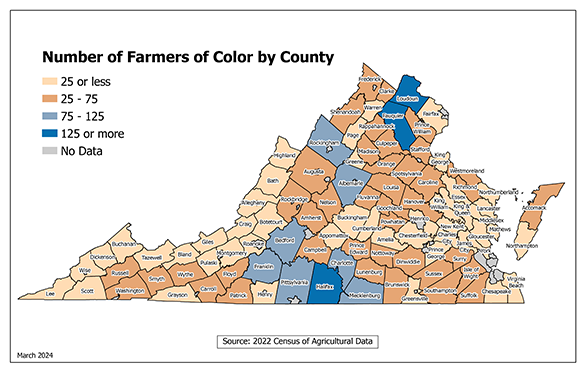Soil and Water Conservation Opportunities for Farmers of Color
Racial Diversity of Farmers in Virginia
From row crops to vegetables, cattle to chickens, farmers of every major racial demographic play an essential role in agricultural production as well as soil and water conservation throughout Virginia. The most recent Census of Agriculture conducted by the U.S. Department of Agriculture in 2022 indicated that Virginia had over 2,500 farmers of color involved in some form of agricultural production. African Americans and Latino farmers make up the majority of this sizable group of Virginia farmers. Other groups represented include Asian American, Native American and Native Hawaiian farmers.
The map below shows the distribution of farmers of color throughout the commonwealth according to the 2022 Census of Agriculture. From north to south, east to west, these farmers make up an important part of Virginia's agricultural and economic fabric. They also play a critical role in the Division of Soil and Water Conservation's efforts to reduce nutrient and sediment pollution, thereby improving water quality throughout the commonwealth's streams, rivers and the Chesapeake Bay.

Community Outreach
The Division of Soil and Water Conservation has developed a community outreach plan to farmers of color in Virginia. As part of this effort, the division has identified professional organizations including racially diverse agricultural and engineering organizations such as Minorities in Agriculture, Natural Resources and Related Sciences (MANRRS) and National Society of Black Engineers; university student chapters of such groups; fraternal organizations; social clubs; farmers markets; houses of worship and more.
The division's goal is to reach out to these organizations in an effort to establish networking relationships with their members. In turn, farmers of color could learn more about, and participate in, the division's various programs and opportunities for financial and technical assistance related to their soil and water conservation needs. The division also intends to identify key middle and high schools to participate in their career days. It will work more closely with the Virginia Association of Conservation District Employees for field days and other outreach activities.
In addition to developing key relationships, the division plans to continue summer, work-study, and other internship opportunities for students. It also plans to seek grants that can provide financial assistance with conservation projects in underserved communities.
Finally, the division will work with Virginia State University’s Small Farm Outreach Program to promote the division's programs and services to farmers of color across Virginia.
Key Soil and Water Programs Available to Farmers of Color
The Division of Soil and Water Conservation offers many programs and services that are available for farmers of color seeking to implement conservation practices on owned or rented agricultural lands.
- Conservation Planning provides a starting point for all farmers interested in water quality. Through the conservation planning process, a farmer can work with their local DCR-certified soil and water conservation district to inventory their operation and any conservation (resource) concerns on the farm. Any concerns can be addressed through recommended best management practices or BMPs. Some BMPs may qualify for Virginia Agricultural Cost-Share Program funds, tax credits or other funding as described below.
- The Virginia Agricultural Best Management Practices Cost-Share Program or VACS is Virginia's premier program for implementing BMPs that reduce nutrient and sediment pollution from agricultural lands, thereby improving water quality across the commonwealth. VACS includes many options for cropland producers such as cover crop, nutrient management planning and precision nutrient management. On pastureland, VACS may assist farmers in the fencing out of livestock from their streams, the development of alternative watering systems and grazing land management. There are also eligible BMPs for those managing animal waste from poultry, beef cattle, dairy or horses. VACS offers management systems, seasonal feeding facilities, litter sheds, pack barns and other options. With over 70 cost-share practices and 15 tax credit-only options, there is truly something for every eligible producer.
- The Nutrient Management Program provides opportunities for farmers to better manage nitrogen and phosphorus inputs while also saving money on their agricultural lands. DCR has a team of nutrient management specialists on staff who are available to assist them with developing nutrient management plans. Farmers may also choose to work with a DCR-certified private sector planner. Please see the Nutrient Management on Small Farms brochure for those farmers with small farms for assistance at no cost.
- The Resource Management Planning Program assists farmers in developing higher level plans that utilize a suite of best management practices to reduce runoff pollution to local waters. In return for full implementation, the plan holder can be assured that he or she is in compliance with any new state nutrient, sediment and water quality requirements, in particular, regulations related to the Chesapeake Bay and all local stream segment total maximum daily load requirements. The certificate of safe harbor is valid for nine years provided the farmer continues to implement the RMP.
Other Programs of Interest
- The District Engineering Services Program provides technical assistance for the planning, design and certification of structural best management practices.
- The Poultry Litter Transport Program incentivizes the transport of poultry litter, primarily outside of the Chesapeake Bay watershed, for use as an organic crop nutrient source in areas that can benefit from the application of those nutrients according to a nutrient management plan. This program pays $7.50 to $20 per ton of litter moved in order to help cover costs associated with transport.
- The Shoreline Erosion Advisory Service, or SEAS provides technical assistance, planning services to help mitigate erosion, and inspections for tidal shorelines and non-tidal streambanks.
Key Conservation District Contacts
To find your soil and water conservation district, you can visit SWCDs by Locality.
Key DCR Contacts
DCR-DSWC Richmond Office Number: 804-786-2064
DCR-DSWC Eastern Regional (Tappahannock) Office Number: 804-443-6752
DCR-DSWC Western Regional (Staunton) Office Number: 540-332-9991

 Department of Conservation and Recreation
Department of Conservation and Recreation
 Department of Conservation and Recreation
Department of Conservation and Recreation

